I write a great deal about DSP portables, SDRs, and modern ham radio transceivers, but truth be known, my passion is for older rigs–ahem, much older–the antique “boat anchors” of the radio world.
Tuesday afternoon, I had a rather involved soldering project to do on behalf of my organization, Ears To Our World. While I worked, I decided to fire up my Signal Corps BC-348-Q to hear what was on the air. I promptly discovered Radio Exterior de España on 17,850 kHz–starting with their interval signal; REE, care of my BC-348-Q, kept me company while I soldered almost three hundred connections.
I listen to my BC-348-Q nearly every week. Usually, she’s tuned to 9,580 kHz for my morning dose of Radio Australia. In the winter, the ‘348’s tubes keep my little radio room a little warmer than the rest of my house. In the summer–well, I just sweat a little more.
I love this radio, and my other “boat anchors,” because when I listen to these rigs I can’t help but hear the past. I wonder about the others who have listened to the same radio, and what was happening in their lives as they listened…
The BC-348 series, for example, is well-known for its use in WWII allied bombers–these rigs were mounted in the likes of the B-17, B-24, B25, and others of the era. Indeed, mine still has the original clips on the base that anchored it to the radio operator’s onboard work table. The ‘348 was used as a long-distance liaison receiver during WWII.
The BC-348 series was built with simplicity, functionality, and serviceability in mind. It was built to withstand life on a B-17 bomber–the extreme vibration on start up, the extremely low temps in the upper atmosphere; it could be serviced by the radio operator in flight, if necessary. Its controls are simple, bare-bones, even. The tuning knob and analog dial are beautifully engineered and precise.
The ‘348 has a power switch, volume control (switchable from auto to manual gain), crystal filter, CW switch, beat frequency control, tuning knob, and a band switch (located just below the dial). The antenna and ground terminals are mounted on the front of the radio for easy accessibility. All controls are spaced so that the radio operator could use the ‘348 even while wearing thick cold-weather gloves.
You can’t do any medium wave DXing on the ‘348, however: this receiver was intentionally designed with the medium wave band omitted. Evidently, Uncle Sam wanted radio ops to be focused on communications instead of entertainment (but that’s okay; the government also made morale radios for the latter).
When I go to the Dayton Hamvention–or any hamfest, for that matter–it’s radios like the BC-348-Q I seek. Tube/valve radios sometimes lack the sensitivity and (digital) accuracy of modern tabletop shortwave receivers, but they make up for this in audio fidelity. As long as you have a properly-matched speaker, the sound can be…nothing short of amazing. Even though the ‘348 was never designed for robust audio, it still sounds richer and fuller than most modern tabletop radios. The sound is so warm it literally glows. Moreover, I’d be willing to wager that there are few modern receivers that can stand the test of time like these rigs.
If you buy one of these old beauties, you must be ready to service them; inevitably, a capacitor or tube will fail in time. But they just…keep…going.
I’m very much in debt to my good friend and radio elmer, Charlie (W4MEC) who kindly teaches me everything I need to know about these great rigs. He’s exceedingly patient, and that counts for much, as I’m not by nature technically inclined. But I do enjoy learning about these radios and how to service them; the romance of their history draws me in, and I simply can’t get enough.
Note: It’s important to work with a knowledgeable elmer/mentor or a professional repair technician when servicing these boat anchors, because, unlike with our modern radios, their high voltages can severely injure (or even kill) you if you don’t know exactly what you’re doing inside the chassis. This is repair work for the professional.
My BC-348-Q turns 71 this year–and I’m sure it has at least that many more years to go. I know that I’ll give it as much TLC as it can take. We must keep these still functioning pieces of history on the air.
If you, too, have boat anchors or antique radios alongside your modern rigs, please comment! I’d love to learn about your favorites. In other words, what heavy metal is in your shack?
Resources:
- Search for a used BC-348:
- More info on the BC-348-Q

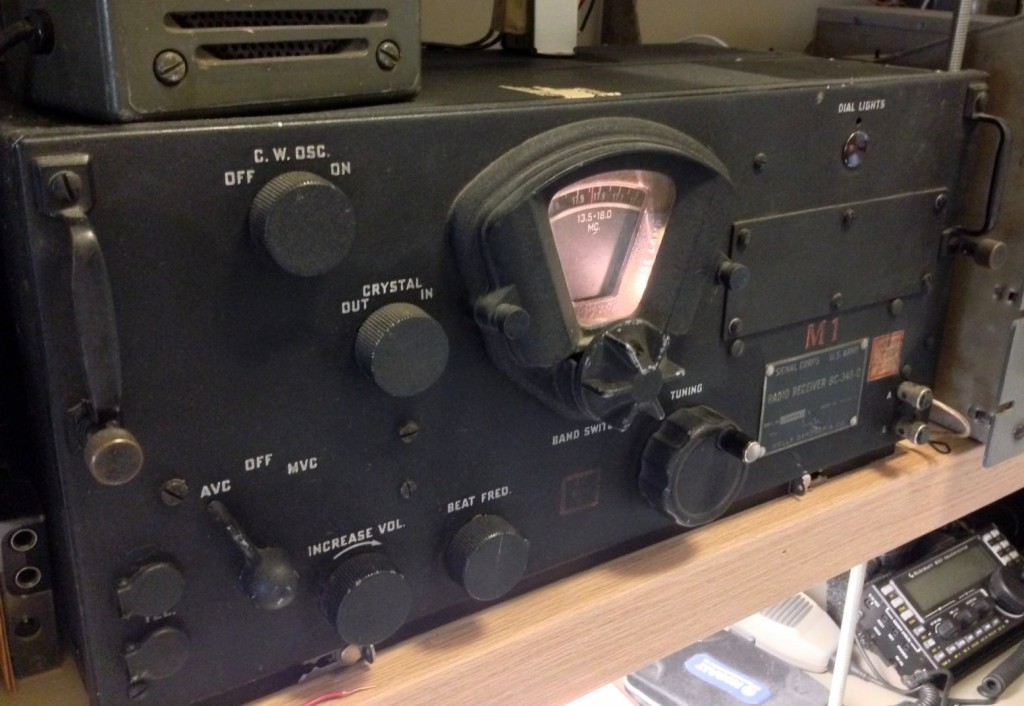
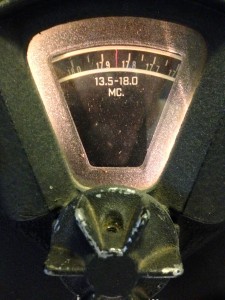
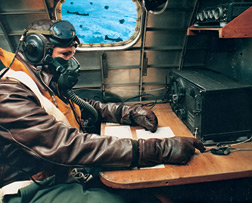
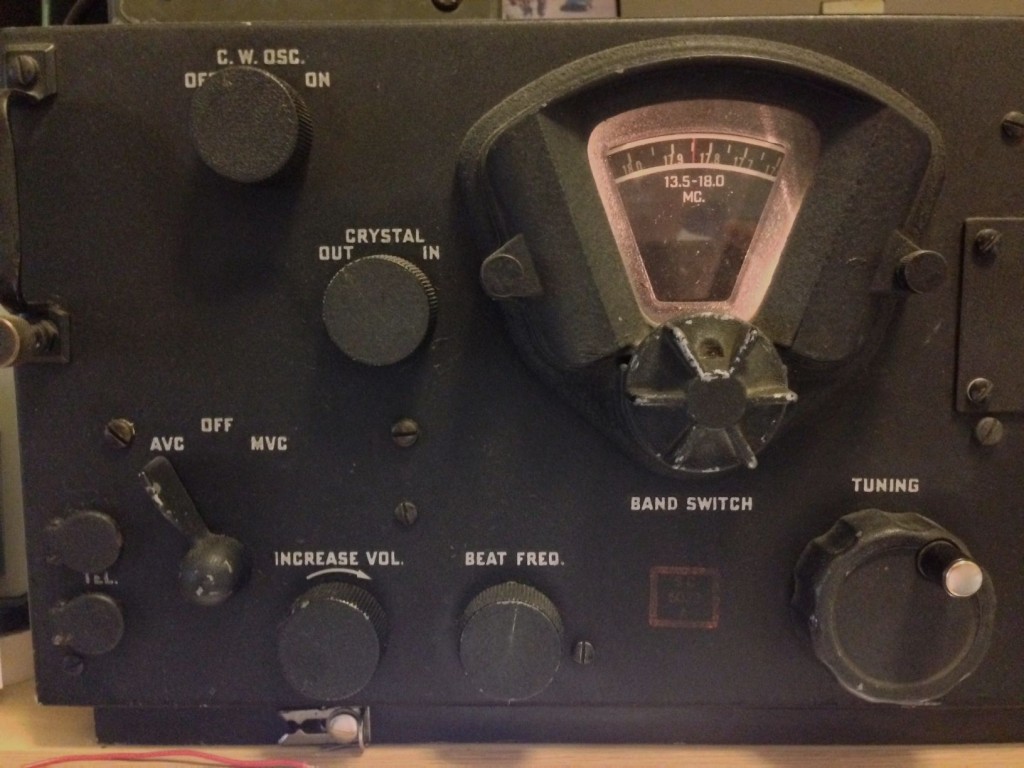
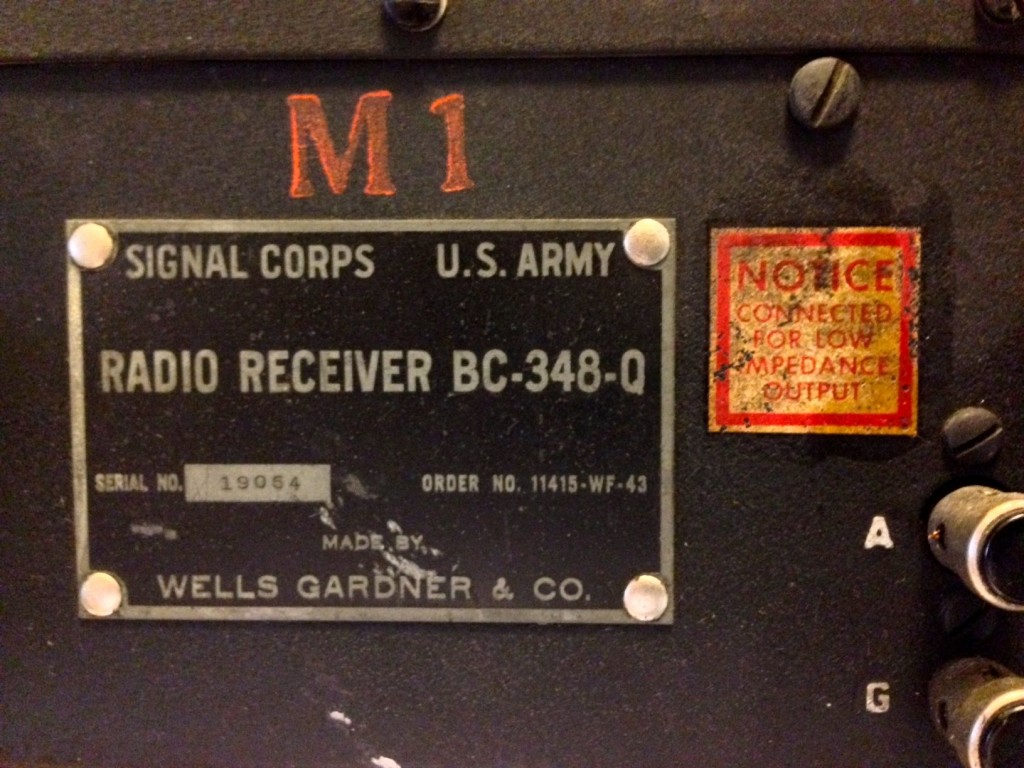
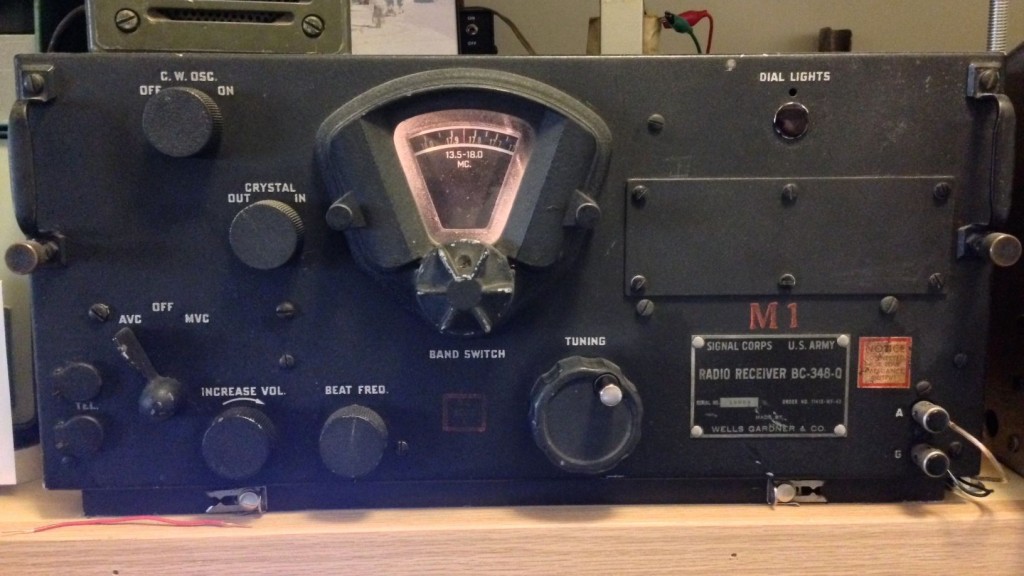
Hallo Freunde
Hier ein Beitrag aus der Schweiz. Ich habe mir für meinen alten Willys CJ-3A Ex-Swiss-Army einen BC-348 aus USA ersteigert. Dieser wurde nach dem WW2 von der US-Army in Deutschland aus surplus-Beständen gekauft und in Schweiz für den Flugfunk eingesetzt. Da ich aber nicht nur ein altes Stück Eisen auf dem Willys spazieren fahren wollte, bat ich einen pensionierten Fachmann, die Stromversogung zu erstellen (Umformer fehlte) und den BC-348 durchzuchecken. Nun läuft er und im Winter steht er in meinem Büro und ich arbeite mich nun in die Materie des SW-Listening ein.
Letztes Jahr ist mir noch eine DU-1 Loop-Antenne in die Hände gefallen. auch dort hat mein Fachmann die Stromversorgung erstellt und nun ist sie dem BC-348 vorgeschaltet.
Leider wiess ich nicht, wie ich Euch eine foto zumailen kann.
The museum style saving has all been done. I’m one of the ‘dying breed’ who owned this sort of equipment…through hard yakka, working over 60 hours/week whilst at school and collecting scrap metals, scouring the tips at Mosman and Narremburn ……commencing from say within 13 years of WW1. We were another dying breed also…the SWL…short wave listener on console short wave radios ,the regen sets we built and such military radios as the 348, AR8, HRO, ARB, 3BZ, Command sets,, AR7, AR88,B-40, 31, 38, 101, 62, 19, 22, 11, 109, R1155 and so on and on.
I refurb’d all those sets and their transmitters but today it is better, I say, to replace all their resistors and capacitors and lousy wiring (if not mil-spec). Rebuilding cancer- causing capacitors is pointless as is keeping ‘originality’ in components….Rebuild beautifully…think about what you are doing at every step and make your set a thing of which to be proud. Much of the post war CQ etc mods were worse than leaving sets as they were. Every military set was built to sound philosophy by experts. Unless you are off with the pixies flying some crate to say commit genocide in Japan…which is the commonplace hook for the 348…totally irrelevant..respect the set, think about the spec-accruers, designers, draftsmen, testers,, component creators, constructors, users and ‘echelon servicemen and women but in respect for them change all those components you can, for modern components.. of the right type for the job. Do the replacement beautifully. Then align and use your set…it will be way ahead in fun that some Japanese mass produced, often faulty gear…get involved, recover Ham radio from the lounge chair jabber jabber and breach of almost all Amateur Service tradition…which began with the “Z” call egomaniacs who despised HF. and considered themselves above the commoners using “code”. One at least is still directing the WIA.
Bringing the WW11 radio, even 30’s gear .. and the 348R is just one icon… into modern componentry will give fantastic results. Look also at using a BC1206 or BC 453 as ‘Q-five’. With all the b/s about sets ‘dragging/hauling/pulling-in signals you know it’s just a lust for power and recognition that drives people to have and buy “the best”, including boring junk like digital, JRC, Kenwood, Icom, Ten Tec and the like. Amateur Radio is not about telephone conversations but about experimentation and science. Find an unspoiled 348 or 342 …and one sign of ‘spoiled’ is an S meter +/- filling the gap of the dial light pot… (although I have one on a very specialised 348 brought out from Holland post WW11… but on completely new and wider front panel). Don’t pay prices asked by exploiters….a really good and complete and ‘spot-on’ 348 should not cost over $300US.
The despoiled garbage 348’s on eBay at present, some been there for over a year, are at ludicrous prices and typically rip-off US and eBay profit-added postage,.. as well as overcharged GST . Be circumspect ..there are still tens of thousands of 348’s around and the one I bought last week is a mighty example of top class, professional, work in mods. It cost me $240US plus correct postage of $84 US for priority postage. That was a great buy but at say $350 US, for me who has 4 others really interesting348’s… no…too expensive. Here mine is worth a good $500.00..they are ‘special’.
eBay vendors are using postal overpricing to profit from our buys…so buy the best, pay the least and go right through the set with modern caps and resistors….then enjoy it…enjoy its ‘limitations’. its knob twiddling signal resolution, its style and its soul. It will love you for giving it anew lease of life.
Become an SWL.. a short wave listener on 190kHz to 18mHz…including say with an old car radio which has an RF stage…the broadcast band dx. Recover the Amateur Radio Service, inspire the ARRl. RSGB and other radio societies and politicians with your SWL enthusiasm ..learn the Morse-code and listen to it…maybe even convert a mantle or console old SW radio to having a synchronous detector. Don’t seek to hear everything, to be the best,,, that’s not AR. Seek to experiment, communicate your experiments and get involved with your receivers…..Voila.
I recently bought one of these beauty’s and the main reason why I chose this similar radio was because of my interest in the golden years of shortwave and the links from my first shortwave listening experiences when I was at the age of 10. I came in contact with UVB-76 which is to this day still my guide who gave me a mysterious but warm welcome to the amazing world of radio. Mines similar to the one above but it’s from Russia. That’s what makes this radio special for me as it links to my first shortwave experience in my life.
Emilio, I’ve never had a 348 with inadequate volume…for headphones. The output impedance is likely 300 ohms and you probably have a substantial mismatch to an 8 ohm speaker. Setting aside building a small matching network…an I don’t see a 300 ohm or close resistor in series with your speaker as much of a solution.
It maybe that your set has tubes down on emission and/or the set needs ‘peaking’ or has faulty capacitors or resistors…In other words don’t start at the wrong end…get the set working well and worry about audio later. There would be many BC 358 Q repair videos on Utube and an enquiry at your local Amatuer radio club or ham could see you find a competent repairer…Maybe there’s someone not far from you who’s on the ball with the 348….or is a competent older fellow, used to valve/tube radios and has the gear to align your IF’s etc and crystal cct….often the crystal is not matching the IF frequency so when you switch it ‘in’ performance drops substantially. The idea is to determine the crystal frequency and align the IF’s to its frequency.
That aside, if you like a speaker seek a 300 ohm to nominal ‘speaker impedance’ transformer….
Hook secondary of the firmly mounted transformer (maybe in speaker box) to your speaker primary and nicely and sturdily to the secondary a nice lead and jack plug so as to match the set impedance.
I don’t know how competent you are of course….however…you can remove the output transformer and replace with a ‘standard’ VALVE/TUBE out put transformer…or build that amplifier you want…as in for example. http://www.vermontficks.org/bc348a.jpg. You could also find a tidy spot to tidily install that output transformer and extend the leads to the original output transformer(after disconnection. Once a purist I think removing the existing transformer and storing it, or building the amp cct as in (say) that URL might be best…or find some 300 ohm earphones or…..I go back to my original suggestion…ensure the set is working beautifully first, change all caps especially at power and audio but likely in the coil cans…to do the best job….have it aligned and new tubes fitted with the old ones for spares in performance difference minimal..then see if you need more audio….if you’ve lost sensitivity and alignment and/or discrete components are well out of spec (more than 10%…and remember “out of tolerance” can give an overall increase or decrease in stage and inter-stage values) you can run 500 watts output and still have poor performance.
Hi, i have one of these. I have a question The speaker is connected directly from TEL jack output?, because my BC-348Q have low volume always and need connect to AF amp.
Thanks for share, and sorry for my awful english im from Chiapas, México.
I enjoyed reading about your favorite vintage receiver here Thomas. Henry WA7YBS has a fantastic page on the BC-348 at http://www.radioblvd.com/bc348_dynamotor.htm in which he sings it’s praises.
Thank you for sharing!
Dave
AA7EE
Thanks, Dave! Glad you enjoyed it. Yes, the WA7YBS page is invaluable if you want to learn about the BC-348 series. Amazing amount of info there–I love reading this sort of thing.
I think one of these heavy metal WWII receivers should fit nicely in your QTH, Dave. They’re kitty proof, too!
Cheers,
Thomas
K4SWL
As a teenager I had a British military WW2 receiver, model R-107, and have thought about having another boat anchor ever since. If I do, I think it might be a National HRO. I seem to have a thing about plug-in coils 🙂
I’m not sure if anything is 100% kitty-proof. That fur has a habit of turning up everywhere!
Dave
AA7EE
Wow! an R-107! I would encourage you to keep a look out for a National HRO. That’s a radio I’d love too. One massive HRO knob, plug in coils–oh yeah. Beauty through simplicity.
I imagine your kitties would quickly discover how warm the chassis gets on some of these radios. Especially on a cold night!
Cheers,
T
I own and use several modern radios but my collection is made up of numerous boatanchors that get regular use. My main ham radio station consists of a Ten-Tec Omni Plus and until recently an Icom IC-737 tranceiver (now replaced by a FTDX3000). Right beside these radios is the vintage station consisting of A Hammerlund HQ-170 receiver (ham bands only) paired with a Hallicrafters HT-37 transmitter. They both share the same antenna through a Dow relay. The receive quality of the Hammerlund is awesome (it does require a 30 minute warmup to stay on frequency). Also on my desk (it’s a big desk) is an National HRO 60. This radio has very nice receive and comes with features that help isolate a signal. I recently did a partial overhaul on it after it refused to turn on. The repair of the HRO is covered on my blog site ( http://www.Idlenot.com). I also have a video of in in operation on YouTube.
High up on a shelf is my first receiver, the Hallicrafters S-120. A visit to YouTube will show me using it back in 1961 or ’62. The video was converted from 8mm film. I am still listening.
Well Thomas, Sadly, I don’t have A ham licence (money was the issue back then, and now Bureaucracy). but, I was SWLing long before I knew it (I was maybe 6 years old).
Now, along with my Sangean ATS909, I’m using A radio I got second hand and recapped it.
It is an Israeli made radio from the 1950′, Ben-Gal model “Verdi”: six tubes (5 + the EM84 tuning eye).
It has long wave, medium wave,(both marked only in meters), and 2 shortwave bands starting from 2.3Mc to 8.5Mc (As “SW2), And from 8.5Mc to 22.5Mc (As “SW1).
And Though It lacks an RF stage, it is very sensitive. with a 15M wire going out of the living room window and along the fence in a horizontal L shape, it pulled in one night A station identifying itself as coming from Brasil (!). needless to say that CRI, AIR, TRT, RRI And IRIB are coming in so strong, the tuning eye gets to glow full range.
It is my daily use radio, and A love at first sight to all my guests.
All the best,
Moshe Z.
Excellent, Moshe! Your Ben-Gal Verdi sounds like a great radio. I wasn’t aware of this model, either. Thanks for sharing!
Thomas
Thomas,
lovely receiver, and what a joy to use I’m sure. I have an AR88 which sadly, I don’t get to use these days. I am somewhat confined to having a radio (FRG-7) on a small table in the corner of our lounge. The ’88 wouldn’t fit in the space, and if it did, it would break the table! what was once my radio room/workshop is now my son and daughters recording studio, given over to them (temperally) to try and further their music careers. The day they leave home, that area will be re-requisitioned and the AR88 fired up. Although by that time, it may require some remdial work.
But there is something special about using a receiver that was once used by a bomber crewman, or someone else connected to a moment in history.
regards, Charlie
You know, Charlie, I know many a musician that likes incorporating those analog shortwave sounds in their recordings. Perhaps the AR88 should just “appear” in their studio? 🙂 Ha!
I hope your son and daughter are successful and that you get your radio room back soon! Bring that AR88 up slowly on a variac if it sits too long. Need to get those capacitors juicy again.
Cheers,
Thomas
I have a not working 348-P which was “modernized” , clunky over sized “S” meter added top right side. I hope to restore in the near future, mostly just because it looks soooo cool.
The lament about modified equipment is really a modern day issue.
People forget, or never knew, how plentiful WWII equipment was, and thus cheap. Even in 1972, I could buy a Command Set transmitter for ten dollars at the local electronic store, and it had never been used. Well, at the time that seemed long after WWII, but 42 years later, the war was barely over.
So there was endless stuff on the market, real cheap. Some of it could work, with some modification (because it was intended for aircraft use, or remote control, or whatever), some of it had really little value as is, because it did nothing useful for the hobbyist, or because it didn’t tune anything useful. People weren’t looking at history, it was too close to the event, they were looking at that cheap stuff and figuring out how they could use it instead of paying big bucks for something new. Yes, even the fact that it was cheap factored in, you don’t want to damage your new $500 receiver, but if you got one for $75, if it adds something you want, or maybe improves it, you might as well. One can argue that for some equipment, modification represents the reality of the post war era, that some stuff was never used without modifying it first.
When I got my ham license in 1972 and started going to the local ham club auctions and fleamarkets, it was really easy to get tube equipment and cheap. Everyone wanted transistors, and everyone wanted SSB rather than AM. Some of it I didn’t even have to buy, it was just given to me. And since it was cheap, I’d trade it for something else after a while, the traded stuff would now bring in big bucks.
But one reason it is now valuable is that actual use and discarded winnowed out the supply. When something gets old, nobody wants it, it becomes cheap. It’s only later when people want what they used to have or couldn’t buy when they were kids, that the price goes up. And since there has been attrition (precisely because it was deemed useless at some point decades ago), the supply is smaller, and thus the price goes up.
I was really lucky to get that GPR-90 for $20 two years ago, but that is a real exception.
That said, one really has to think twice today about modifying old equipment. No matter what is done to it, one can likely get better performance from something more recent and cheaper. And precisely because prices go up, one thinks twice before modifying, “resale value” becomes factor, just like decades ago when someone would hesitate to modify their new HRO because it would impact on reselling price. And so few are intact, and it is now history time, it seems keeping the old intact now makes more sense than trying to hotrod it.
Michael